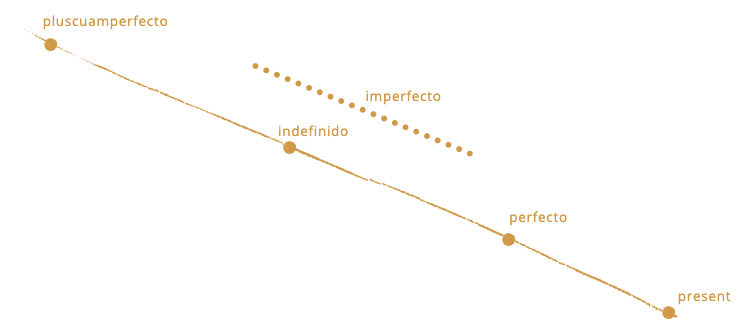There are four past tenses in Spanish; the perfecto, the indefinido, the imperfecto and the pluscuamperfecto. These four tenses dance together when we tell stories about the past or anecdotes… The four are necessary to express when the action happens, but also to set up the context of that past story. In this blogpost, I want to give you a visual overview of the four tenses for those of you with more visual minds. In previous posts I have shared with you, I talked about the different past tenses (which have videos, text and practise exercises in them). Once you’ve read this post you can come back and revise these additional posts on the topic of past tenses (but for now, let’s get to the visual timeline explanation):

“The past is always tense, the future perfect.”
― Zadie Smith
Visualise the timeline below where the four past tenses have a very specific place in it (and are always in connection with the present and with the other actions).

The 2 Key Points to Understand the Relationship between the pasts Tenses
There are two key elements to take into account when it comes to understanding the dance between the past tenses. One is the perspective + intent, and the other one is the time frame when that action takes place.
Let’s play with four sentences talking about the same action in the past.
– He leído un libro sobre Séneca.
– Leí un libro sobre Séneca.
– Leía un libro sobre Séneca.
– Había leído un libro sobre Séneca.
All of these sentences talk about an action (reading a book) that happens in the past. But, what is the perspective + intent of the speaker with each one, and second, what’s the time frame for each one?
He leído un libro sobre Séneca means that this person read this book in a time frame that is still current: this week, this month, this year… this lifetime. If the person wants to express that reading a book about Seneca is a life experience, then it will use the Perfecto, because the lifetime is still current – as long as the person is still alive, of course –.
But leí un libro sobre Séneca expresses a different intention and time frame. The intention is that it happened once in the past, It also tells us that action is over now and finished in a time frame that is also past and has no connection with the present.
Whereas the sentence leía un libro sobre Séneca, albeit being also a past and finished action, expresses a different intention: maybe it was a repeated action, for example, I read Seneca every day during summertime. Or maybe the intent is to express that reading Seneca was the context of the action… Also, the time frame is different as we are not expressing a specific point in the past but a more fuzzy time frame (we don’t know the exact point in time and we don’t care).
Finally, había leído un libro sobre Séneca expresses a different time frame that indicates that the action happened before other past action.
As you can see, the intention and perspective of the speaker, along with the time frame the action is set in, are the two key factors you have to take into account when choosing between tenses.


